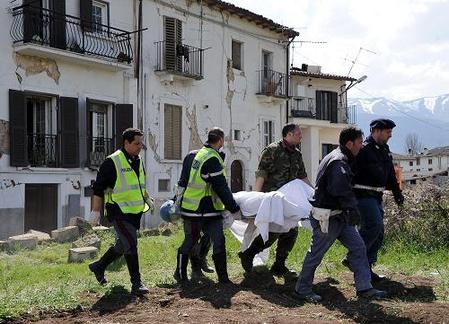Rescue workers using bare hands and buckets searched frantically for students believed buried in a wrecked dormitory after Italy's deadliest quake in nearly three decades struck this medieval city before dawn Monday, killing more than 150 people, injuring 1,500 and leaving tens of thousands homeless. The 6.3-magnitude earthquake buckled both ancient and modern buildings in and around L'Aquila, snuggled in a valley surrounded by the snowcapped Apennines' tallest peaks.
It also took a severe toll on the centuries-old castles and churches in the mountain stronghold dating from the Middle Ages, and the Culture Ministry drew up a list of landmarks that were damaged, including collapsed bell towers and cupolas.
The quake, centered near L'Aquila about 70 miles northeast of Rome, struck at 3:22 am, followed by more than a dozen aftershocks.
Firefighters with dogs and a crane worked feverishly to reach people trapped in fallen buildings, including a dormitory of the University of L'Aquila where a half-dozen students were believed trapped inside.
After nightfall Monday, rescuers found a scared-looking dog with a bleeding paw in the half-collapsed dorm. Relatives and friends of the missing stood wrapped in blankets or huddled under umbrellas in the rain as rescuers found pieces of furniture, photographs, wallets and diaries, but none of the missing.
The body of a male student was found during the daylight hours.
"We managed to come down with other students but we had to sneak through a hole in the stairs as the whole floor came down," said Luigi Alfonsi, 22, his eyes filling with tears and his hands trembling. "I was in bed -- it was like it would never end as I heard pieces of the building collapse around me."
Elsewhere in town, firefighters reported pulling a 21-year-old woman and a 22-year-man from a pancaked five-story apartment building where many students had rented flats.
Amid aftershocks, survivors hugged one another, prayed quietly or tried to call relatives. Residents covered in dust pushed carts of clothes and blankets that they had thrown together before fleeing their homes.
Slabs of walls, twisted steel supports, furniture and wire fences were strewn in the streets, and gray dust was everywhere. A body lay on the sidewalk, covered by a white sheet.
Residents and rescue workers hauled debris from collapsed buildings by hand or in a bucket brigade. Firefighters pulled a woman covered in dust from her four-story home. Rescue crews demanded quiet as they listened for signs of life from inside.
RAI television showed rescue workers gingerly pulling a man clad only in his underwear from a crumbled building. He embraced one of his rescuers and sobbed loudly as others placed a jacket around his shoulders. Although shaken and covered in dust, the man was able to walk.

Some 10,000 to 15,000 buildings were either damaged or destroyed, officials said. L'Aquila Mayor Massimo Cialente said about 100,000 people were homeless. It was not clear if his estimate included surrounding towns.
Premier Silvio Berlusconi said in a TV interview that more than 150 people were killed and more than 1,500 were injured. He had already declared a state of emergency, freeing federal funds for the disaster, and canceled a trip to Russia.
The quake hit 26 towns and cities around L'Aquila. Castelnuovo, a hamlet of about 300 people southeast of L'Aquila, appeared hard hit with five confirmed dead. The town of Onno, population 250, was almost leveled.